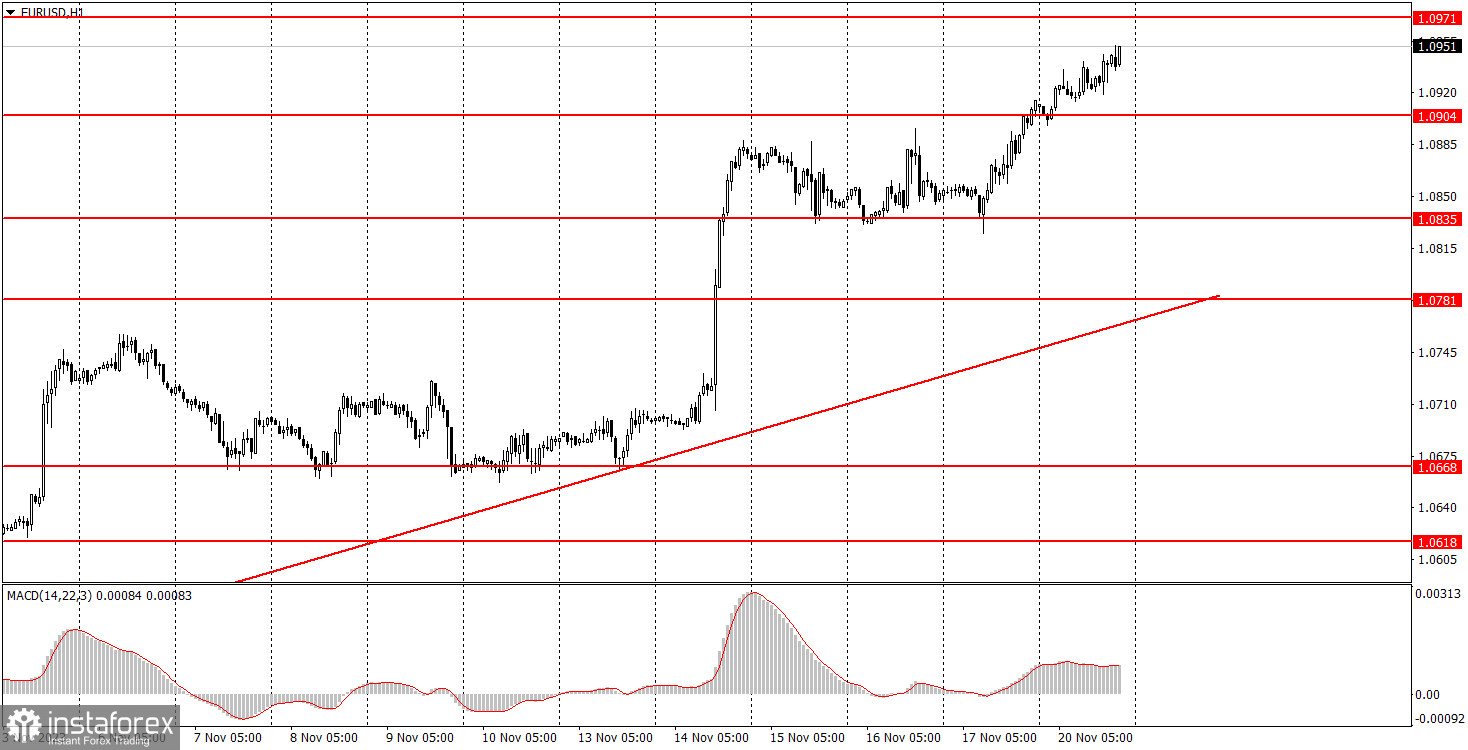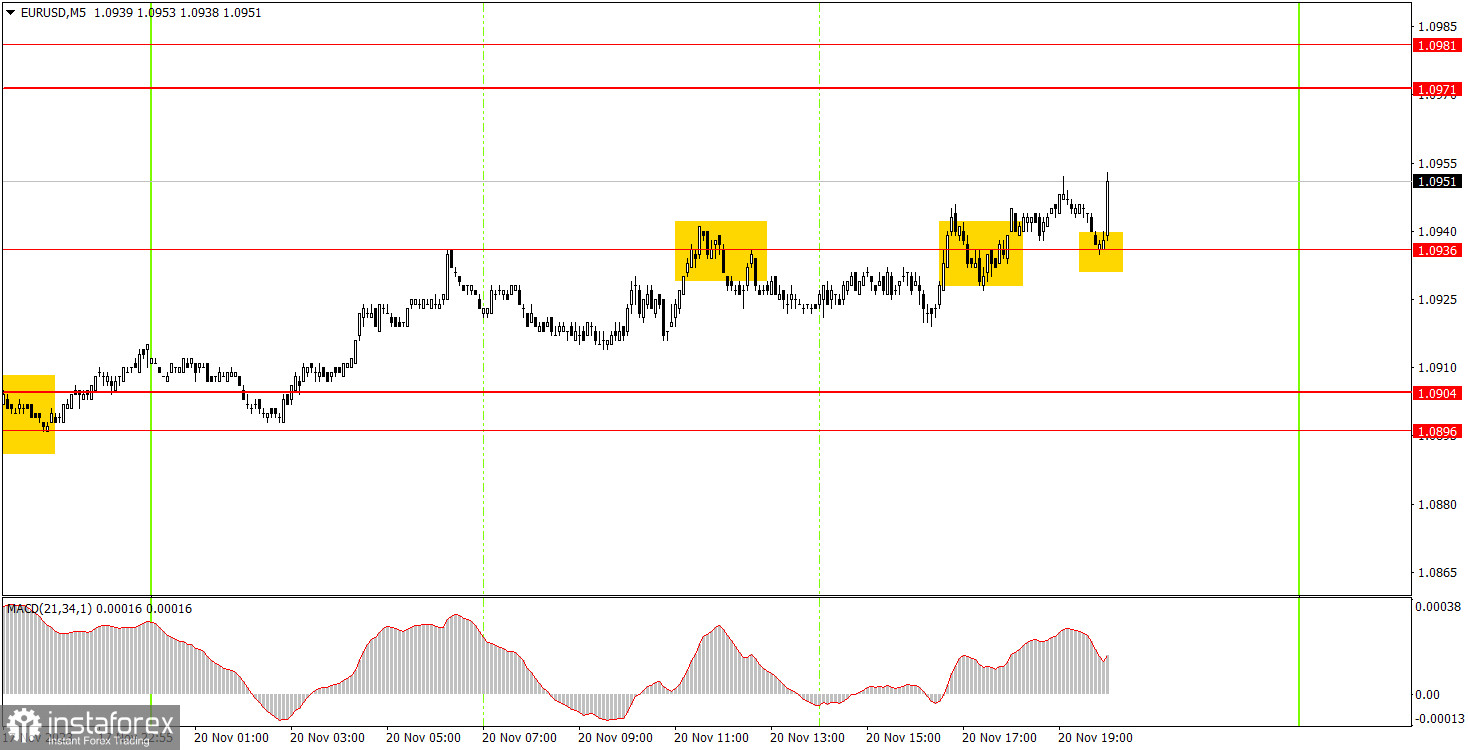Analyzing Monday's trades:
EUR/USD on 30M chart

EUR/USD was able to easily extend its upward movement on Monday. We had doubts about the rally on Friday, as not only were there no grounds for it, but there were also no economic reports in sight to support it. But then there were no reports on Monday either. Traders hardly paid attention to the producer price index in Germany, in fact, this is not even a secondary, but a tertiary report. Obviously, it did not trigger the euro's growth.
And so the euro continues to rise, and for five or six days now, it has raised very big questions. This movement resembles a sort of momentum, where the market buys the pair only because it is rising. At least, we do not see any fundamental and macroeconomic reasons for the euro to rise.
EUR/USD on 5M chart

On the 5-minute chart, three trading signals were generated, but the total volatility was just 54 pips. As it found its first level on the way, the pair managed to test it several times and overcame it. There wasn't much to look forward to even in the face of what seemed like a trend movement. Each of the signals led to a movement of a maximum of 10 pips. Unfortunately, it was another "boring Monday."
Trading tips on Tuesday:
On the 30-minute chart, the corrective phase remains intact. It started another round of this phase due to the U.S. inflation data. Despite the substantial growth, a correction is still a correction. Therefore, we expect it to come to an end and the downtrend to resume. Currently, we have an ascending trend line, so we can determine the end of the corrective trend. The key levels on the 5M chart are 1.0568, 1.0611-1.0618, 1.0668, 1.0733, 1.0767-1.0781, 1.0835, 1.0896-1.0904, 1.0936, 1.0971-1.0981, 1.1011, 1.1043, 1.1091. A stop loss can be set at a breakeven point as soon as the price moves 15 pips in the right direction. On Tuesday, there is no significant event planned in the European Union and the United States. We can only highlight the minutes of the Federal Reserve's last meeting, which is just a formality and will be published late in the evening and by then, beginners have probably left the market.
Basic trading rules:
1) Signal strength is determined by the time taken for its formation (either a bounce or level breach). A shorter formation time indicates a stronger signal.
2) If two or more trades around a certain level are initiated based on false signals, subsequent signals from that level should be disregarded.
3) In a flat market, any currency pair can produce multiple false signals or none at all. In any case, the flat trend is not the best condition for trading.
4) Trading activities are confined between the onset of the European session and mid-way through the U.S. session, post which all open trades should be manually closed.
5) On the 30-minute timeframe, trades based on MACD signals are only advisable amidst substantial volatility and an established trend, confirmed either by a trend line or trend channel.
6) If two levels lie closely together (ranging from 5 to 15 pips apart), they should be considered as a support or resistance zone.
How to read charts:
Support and Resistance price levels can serve as targets when buying or selling. You can place Take Profit levels near them.
Red lines represent channels or trend lines, depicting the current market trend and indicating the preferable trading direction.
The MACD(14,22,3) indicator, encompassing both the histogram and signal line, acts as an auxiliary tool and can also be used as a signal source.
Significant speeches and reports (always noted in the news calendar) can profoundly influence the price dynamics. Hence, trading during their release calls for heightened caution. It may be reasonable to exit the market to prevent abrupt price reversals against the prevailing trend.
Beginning traders should always remember that not every trade will yield profit. Establishing a clear strategy coupled with sound money management is the cornerstone of sustained trading success.





















